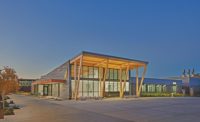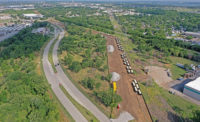Silicon Valley Clean Water Gravity Pipeline Project
Redwood City, Calif.
BEST PROJECT
Submitted by: Barnard Construction
Owner: Silicon Valley Clean Water (SVCW)
Lead Design Firm: Arup
General Contractor: Barnard Bessac Joint Venture (BBJV)
Owner's Advisor: Kennedy Jenks Consultants
Owner's Quality Assurance: Tanner Pacific Inc.
Subcontractors: Environmental Science Associates; Future Pipe Industries Inc.; Griffin Soil; Herrenknecht Tunneling System USA Inc.; Kelley Engineered Equipment LLC; Malcolm Drilling Co.; Pacific International Grout Co.; Traylor Shea Precast AJV; Tri-Valley Excavating Co.; Wang Technology LLC
Silicon Valley Clean Water undertook this project as part of a $580-million Regional Environmental Sewer Conveyance Upgrade Program to rehabilitate and convert its 50-year-old raw wastewater conveyance system that was at the end of its useful life from a force main system to a gravity conveyance system.
The gravity pipeline is the authority’s primary wastewater transport system, carrying raw wastewater from pump stations to a headworks facility. The project consisted of the design and construction of 3.3 miles of fiberglass reinforced polymer mortar pipe inside a concrete-segment tunnel and three shafts. The owner wanted a new system to serve the public, support community health and protect the environment for 100 years.
This was the first tunnel-boring machine project in North America completed using a progressive design-build model. The team ultimately delivered the project under budget and seven weeks ahead of schedule in May 2022.
Rather than a rigid value engineering campaign, the team diligently kept budget and schedule requirements at the forefront while developing the design. The project cost estimate was updated as design progressed, and the contractor prepared numerous cost comparisons. For example, the team creatively chose to “nest” smaller-diameter pipes inside larger-diameter pipes to reduce shipments and save transportation costs. But to monitor ground settlement, the simple solution of a manual daily elevation survey was chosen against the complicated and costly use of automated total stations.
Progressive design-build provided the flexibility and collaboration to improve upon traditional processes used in the tunneling industry. The process made it possible for the client to issue an early Stage 2 amendment to the contractor, before Stage 1 was complete, to order the tunnel-boring machine, which typically takes 12-16 months to fabricate, assemble and ship.
The team also used numerous innovative technical solutions. For example, crews transported spoils to the surface via an inclined conveyor tunnel instead of the traditional crane and bucket method, reducing hazardous overhead loads and increasing tunneling production rates.





Post a comment to this article
Report Abusive Comment